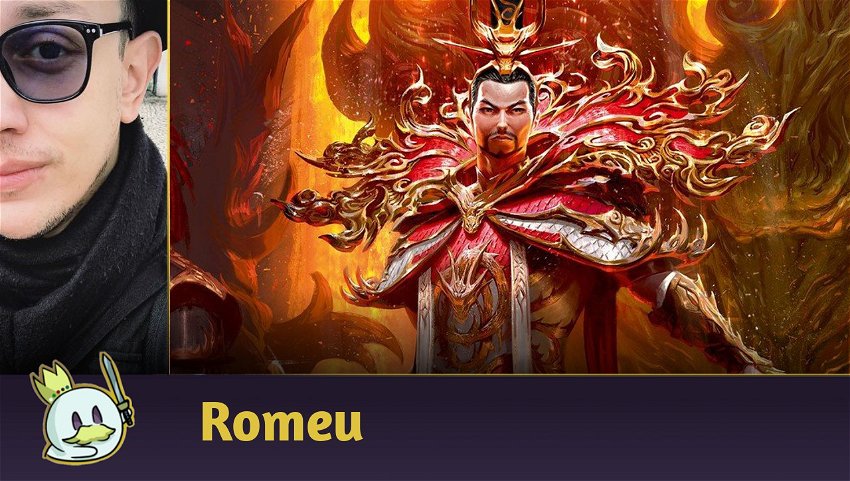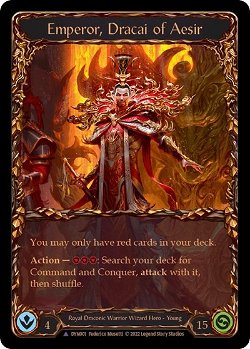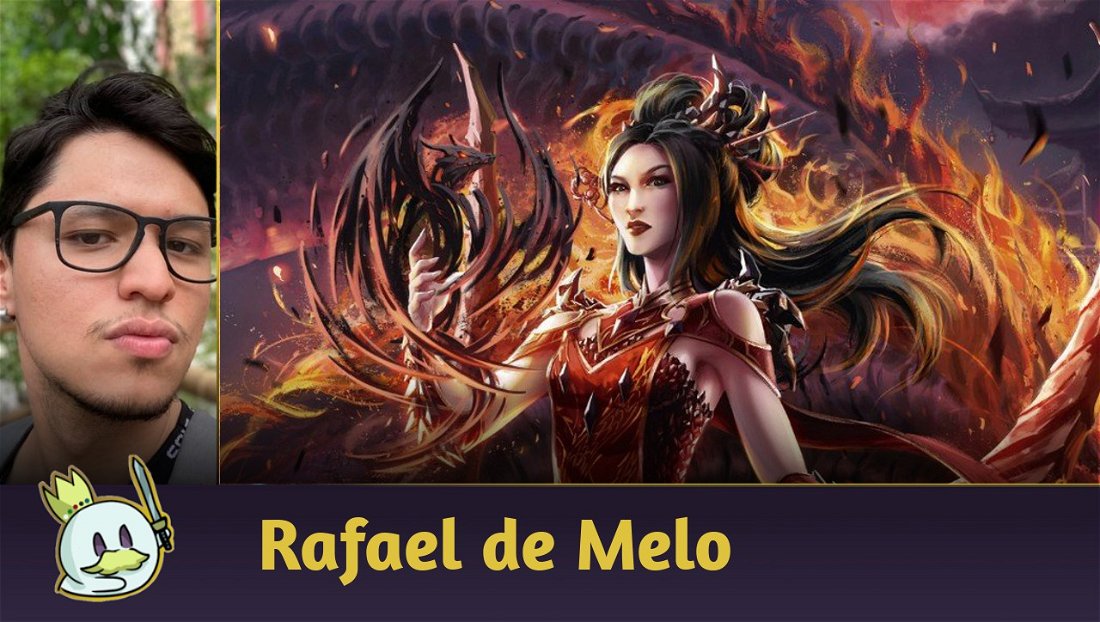Flesh and Blood is only three years old. What seems to be a long time when we consider we were going through a pandemic and a series of changes were happening all around the world, is, in fact, a very short period when compared to other big card games in this industry, such as Magic: The Gathering's 30 years, or Yu-Gi-Oh!'s 25. The result of this is that this game still has a lot to experiment and explore as its universe expands with each new edition.
Dynasty is a perfect example of that: while Uprising
brought the Draconic talent and the "red cards matter" theme for heroes which already had established classes such as Fai and Dromai, this newest expansion brought an entirely new class with Arakni, which we already covered in a previous article. But another very important innovation made was the creation of a character that, though very short-lived lorewise, is extremely important when it comes to testing new limits as to how far a hero's deckbuilding can go - The Emperor.

Emperor is different from everything we have seen in Flesh and Blood ever since the game's conception: he has two different classes and a talent, being a Draconic Warrior Wizard, which means he can use cards that have one or more of these three elements, broadening the scope of possibilities for deckbuilding.
Nevertheless, all of this flexibility has a high price: besides only having 15 health points, Emperor can only use red cards in his deck, and this limits a lot what can go into the list and how to use these options. But I believe this restriction has a reason, and it is something very interesting to explore.
Why can Emperor only use red cards?
I didn't find, while searching very quickly, an outright reason coming from James White or even Legends Story Studio itself regarding why Emperor has this restriction. On one side, this hero cares about red cards the same way any other card that specializes in Draconic, and lorewise, it makes sense that he can only use red cards.
But Flesh and Blood's competitive scene history might give us a more appropriate answer if we look at another set that came out relatively recently: Everfest. More specifically, when we look at the first and quickest hero to reach Living Legends status in the game - Bravo, Star of the Show.

Known as Starvo, this hero had the fastest competitive ascension in the history of the game, and it lasted only four months in Classic Constructed until it hoarded and overfilled the minimum value required to become a legend in the format, reaching the total amount of 1582 points when it finally left the game.
And what made Starvo so powerful? The access to a broadened scope of cards as it was able to use the three existing elements in the game currently made this hero far too efficient and flexible. While all Flesh and Blood heroes have their restrictions and the biggest challenge when it comes to deckbuilding is playing around their mechanics and mitigating the bad options the best way you can, Starvo could play with only the best options inside his elemental combinations. This, in addition to the fact that his passive skill guaranteed dominate with little to no effort, besides access to Pulse of Candlehold, Pulse of Volthaven and Pulse of Isenloft, and control elements such as Channel Lake Frigid and powerful attacks such as Oaken Old and the like, all made him too strong, and we can consider him the first design mistake in the history of the game.

If Emperor had access to yellow and blue cards, even with his reduced health, he would be as powerful in Blitz as Starvo was in Classic Constructed. Warrior and Wizard are classes that operate with very distinct foundations and deal damage in different ways, and while we can see the same diversity regarding physical and arcane in classes such as Runeblade, the potential in attacking with Enlightened Strike and following it up with an Emeritus Scolding (1) or any other card that deals a high amount of arcane damage by pitching just one, would make him absurdly hard to play around - and all of that without considering a possible blue pitching to look for Command and Conquer, activate Razor Reflex (1) and still lose two to three cards in hand to carry on with your turn, and that is without considering the access to other powerful cards from his respective classes, such as Sonic Boom.
That is, the restriction of only using red cards is what makes Emperor palpable and not as harmful to the game's health, and occupies a spot more for experimentation and innovation that Legends Story Studies is trying to bring with Flesh and Blood to test out the limits regarding how far they can go with heroes with multiple classes or talents.
Equipment
This setting and decklist was made available by the player Gabriel Brandão (@brandaotcg).
Emperor is a very hard deck to build and pilot adequately. Its limitations provide him with the possibility of breaking him in check, but they also make hard its appropriate execution and the use of many attacks in the same chain.

Our weapons are Waning Moon and Jubeel, Spellbane. We tend to prioritize the staff because arcane damage is harder to block if your opponent doesn't set up properly, and this can force them to prioritize suboptimal equipment parts to protect themselves.
Jubeel, Spellbane works particularly well against Runeblades and Wizards to create more protections against arcane damage, and as we can't count so much with Arcane Barrier equipment for that. Our trades for resources are always one to one, besides being a decent option when we know some opponent main equipment prevents arcane damage, as it is the case of Storm Striders.

Our base setup is the one presented above: Flamescale Furnace, besides blocking two damage, allows for a small resource boost and some more explosive turns with the right setup. Crown of Providence helps with blocking and filtering the hand or arsenal at the right time.
Braveforge Bracers is in this list merely due to its blocking properties, and can be replaced by other options you might find pertinent. As for Storm Striders, it offers a way of attacking your opponent with a Wizard action in his turn, and it is lethal, specially alongside Emeritus Scolding (1).

Our protection against arcane setup counts with two Spellfray weapons to mitigate a bit this type of damage. However, matches against Wizards such as Kano or Iyslander tend to be Emperor's worst matchups, as he can't hold off arcane damage enough and will hardly be able to be more agile than Kano or hold off Frostbite and/or Channel Lake Frigid's tokens against Iyslander.
Decklist
As we can only use red cards, the focus of this decklist is to try to deal as much damage as possible for as little cost possible, while we try to diversify our damage between physical and arcane to make our opponent's decisions harder when it comes to choosing their equipment and/or how to block each attack.

Our Attack Actions cost zero or one and try to deal a decent amount of damage. The challenge here is to try guaranteeing a decent chain in one turn: start your turn with Scar for a Scar (1) or a Ravenous Rabble (1), or Flamecall Awakening, which have Go Again, allows enhancing cards such as Blaze Headlong or Phoenix Flame a lot, so that, right afterward, you can finish your turn with some other Wizard Action, such as Aether Quickening (1), or with Snatch (1) and guarantee a card in your arsenal at the end of the turn.

Leaving your Wizard actions for last is usually the play, as they will usually end your turn. Besides that, this makes your opponent block suboptimally in case they want to keep their yellow or blue pitches in hand to protect themselves with Arcane Barrier.
Another essential Emperor resource is the Arsenal - because we only have red cards and not always we can stretch our chain, this extra card saved for the following turn is very important for us to create more explosive plays with Flamescale Furnace and to guarantee more resources with our hand without mitigating the number of actions we can perform.

And, speaking of the Arsenal, the main advantage of this hero is the potential to look for Command and Conquer in the deck, and play it with his skill. This card is one of the game's main staples, and six damage is a considerable amount to mitigate without access to Defense Reactions.
However, due to its higher cost, Command and Conquer isn't as essential in Blitz as it is in Classic Constructed due to the fast nature of matches in this format, specially in strategies that want to play with low costs, as it is the case of this deck.

To stretch our turns, we count with Razor Reflex (1) to increase our attacks' powers and guarantee Go Again, besides also Lead the Charge (1), which offers an action point with any action, and so, becomes a more versatile option than Captain's Call (1), as it also works with Wizard cards.

Because we only have 15 health, we virtually have one less turn regarding damage tolerance than most of the other heroes, which forces us to broaden our ways to protect ourselves and, for that, we resort to the best Defense Reactions this format has to offer.
Setup Guide
Honestly, the setup options regarding equipment with Emperor are limited based on the type of damage your opponent deals, and even against Runeblades, the fact you resort to Storm Striders means you don't have much to alter in your defenses.
Mechanologist, Ranger, Warrior, Illusionist, Ninja, Assassin, Brute

The weapon's use depends exclusively on the game posture you want to take in the match, or how much you wish to bet on physical or arcane damage to close out the match. There are matchups in which the opponent's Arcane Barrier is naturally high due to the main equipment they use, and, in these cases, Jubeel is preferable. As for other matches, the base setup of your opponent includes a few or no Arcane Barriers, which increases the opportunities of forcing them to choose suboptimal pieces, or the amount of damage you can deal in one turn.
In case you're facing Kayo, Berserker Runt, take out Braveforge Bracers for Gambler's Gloves.
Runeblade

Against Runeblades, we trade out Waning Moon for Jubeel to guarantee one more way of protecting ourselves against Rosetta Thorn or Runechant tokens created by Grasp of the Arknight and Revel in Runeblood, besides being easier to attack with her than with the staff in case we have to activate Storm Striders' Arcane Barrier.
Wizard

Your best option against Wizards is play for the race and pray that you're faster in your aggression than they are. But Wizards are the worst matchups for Emperor in Flesh and Blood as long as there aren't more efficient ways of protecting yourself against arcane damage without having to pay an exact number of resources;
Conclusion
Emperor is one of the most peculiar heroes that exist in Flesh and Blood today, but his restrictions and reduced health points make him too limited to perform well against Blitz's other heroes.
However, with two classes, one specialization, and also carrying the Royal type, though today there is virtually no support for it, he might become stronger in the future, as he looks like the kind of card that gradually becomes stronger as time goes on. So, maybe three years from now, he might just be a more viable option than he is today?
Thanks for reading!














— 评论 0
, 反应 1
成为第一个发表评论的人